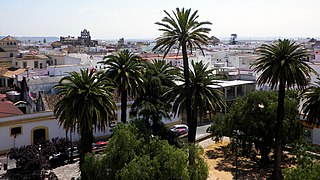
El Puerto de Santa María, locally known as El Puerto and historically in English as Port Saint Mary, is a municipality of Spain located on the banks of the Guadalete River in the province of Cádiz, Andalusia. As of 2016, the city has a population of c. 88,184, of which some 50,000 live in the urban center, and the remainder in the surrounding areas.
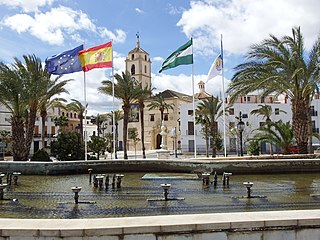
Albox is a Spanish municipality in the province of Almeria in the autonomous community of Andalusia. It is situated in the north eastern part of Valle del Almanzora and 120 km from the provincial capital, Almería. In the year 2017 it had 11,481 inhabitants. Its superficial area is 168.42 km2 and it has a population density of 68 inhabitants/km2.
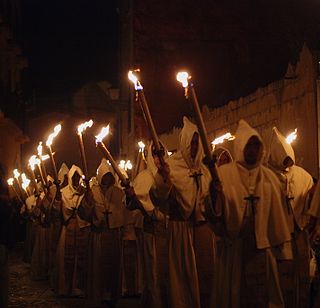
Holy Week in Zamora, Spain, is the annual commemoration of the Passion of Jesus Christ that takes place during the last week of Lent, the week immediately before Easter. Holy Week is the Christian week from Palm Sunday through Easter Sunday. It can take place in March or April. In Zamora, Holy Week is celebrated by 16 Catholic religious brotherhoods and fraternities that perform penance processions on the streets of the city.

Holy Week in Seville is one of two biggest annual festivals in Seville, Andalusia, Spain, the other being the Feria de Abril, which follows two weeks later. It is celebrated in the week leading up to Easter, and features the procession of pasos, floats of lifelike wooden sculptures of individual scenes of sorrowful Mysteries of the Rosary, or images of the grieving Virgin Mary.

Macarena is one of the eleven districts into which the city of Seville, capital of the autonomous community of Andalucía, Spain, is divided for administrative purposes. It is located in the north of the city, bordered to the south by the Casco Antiguo and San Pablo-Santa Justa suburbs, to the east and north by Norte and to the west by Triana. It covers the area between the Guadalquivir River and the Carmona Highway and from the SE-30 ring-road in the north to the Ronda del Casco Antiguo. It contains smaller neighbourhoods such as León XIII, Miraflores, and the Polígono Norte as well as the Miraflores park along the SE-30. The district contains the Andalucian Parliament, the Torre de los Perdigones in the park of the same name, and the Hospital Universitario Virgen Macarena

El Viso del Alcor is a city located in the province of Seville, Spain. As of 2018, the city has a population of 19,191 inhabitants.
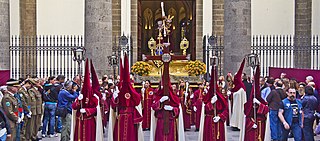
Holy Week in Spain is the annual tribute of the Passion of Jesus Christ celebrated by Catholic religious brotherhoods and fraternities that perform penance processions on the streets of almost every Spanish city and town during the Holy Week –the last week of Lent, immediately before Easter–.

The Via Crucis to the Cruz del Campo in Seville, Andalusia, Spain is believed to be Spain's only Via Crucis that runs through the streets of a city. It is the basis of the famous traditions of Holy Week in Seville. Since the Via Crucis was first laid out in 1521, both the starting and ending points have changed, as has the number of stations.

The Santa Veracruz Monastery in the historic center of Mexico City is one of the oldest religious establishments in Mexico City and was the third most important church in the area in the 16th century. It was established by a religious brotherhood founded by Hernán Cortés.
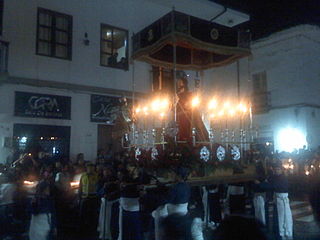
The Holy Week in Popayán, Cauca (Colombia), is the celebration of the Passion and death of Jesus Christ through daily processions continuously performed since the sixteenth century between Friday of Sorrows nights and Holy Saturday. The processions take place in the ancient streets of the "White City". Religious images of Spanish, Andalusian, Quito, Italian and Payanes arranged on a wooden platform with four front and four back "barrotes" (bars) are carried in the shoulders of the "Cargueros". These images are representations of different episodes recounted in the Gospels on the Passion, Crucifixion and Death of Jesus Christ. Each performance is a "paso" (step). The steps are taken through the streets, a distance of a cross-shaped layout since the time of the Conquest, passing by the main churches and temples of the city.

Holy Week in Mexico is an important religious observance as well as important vacation period. It is preceded by several observances such as Lent and Carnival, as well as an observance of a day dedicated to the Virgin of the Sorrows, as well as a Mass marking the abandonment of Jesus by the disciples. Holy Week proper begins on Palm Sunday, with the palms used on this day often woven into intricate designs. In many places processions, Masses and other observances can happen all week, but are most common on , Good Friday, Holy Saturday and Easter Sunday, with just about every community marking the crucifixion of Jesus in some way on Good Friday. Holy Saturday is marked by the Burning of Judas, especially in the center and south of the country, with Easter Sunday usually marked by a Mass as well as the ringing of church bells. Mexico's Holy Week traditions are mostly based on those from Spain, brought over with the Spanish conquest of the Aztec Empire, but observances have developed variations in different parts of the country due to the evangelization process in the colonial period and indigenous influences. Several locations have notable observances related to Holy Week including Iztapalapa in Mexico City, Taxco, San Miguel de Allende and San Luis Potosí.
The Penitential Brotherhood of the Holy Eucharist, founded on May 6, 1959, is one of nine religious brotherhoods of the city of Bilbao that take part in its Holy Week. Bilbao is the most important place for the Holy Week in Spain in the northern part of the country, but not as well known as the Holy Week in Seville. It is canonically headquartered at the Jesuit School, so it is popularly known as the Jesuit Brotherhood. It consists of current and former students, as well as family and friends, but also of people outside the school.

Holy Week in Salamanca is the most important religious event of Salamanca, Spain. It is celebrated in the week leading up to Easter.
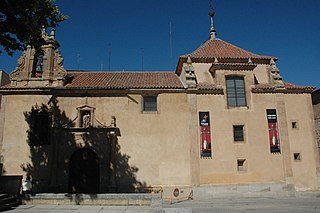
The Illustrious Brotherhood of the Holy Cross of the Redeemer and the Immaculate Conception, his Mother, known as the Vera Cruz or True Cross is a Catholic fraternity established in Salamanca, Castile and León, Spain in 1506.

The Illustrious Penitential Brotherhood of Our Lady of Anguish is a Catholic fraternity established in Valladolid, Castile and León, Spain in 1536.
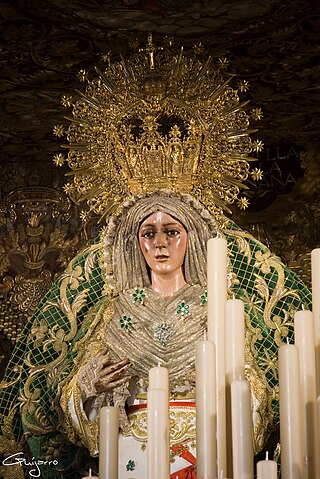
The Virgin of Hope of Macarena, popularly known as the Virgin of Macarena or simply La Macarena, is a Roman Catholic title of the Blessed Virgin Mary associated with a pious 17th century wooden image of the Blessed Virgin venerated in the Basilica de la Macarena in Seville, Spain. The Marian title falls under a category of Our Lady of Sorrows commemorating the desolate grievance and piety of the Virgin Mary during Holy Week. The image is widely considered as a national treasure by the Spanish people, primarily because of its religious grandeur during Lenten celebrations.
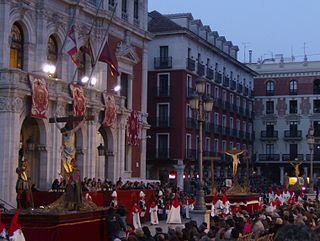
The Holy Week in Valladolid is one of the main tourist attractions, and cultural and religious events of Valladolid and the surrounding province during Holy Week in Spain. It boasts of renowned polychrome sculptures, created mainly by sculptors such as Juan de Juni and Gregorio Fernández, who were active when the city served as the imperial court. The city's National Sculpture Museum has a total of 42 images for the processions. The Holy Week in Valladolid is known to depict the Passion with great fidelity, rigor and detail.
Procession at Seville and bullfighting Scenes is a non-fiction short film created by Auguste and Louis Lumière between 1898 and 1899. The Lumière brothers used a cinematograph to film this motion picture in Seville, Spain.
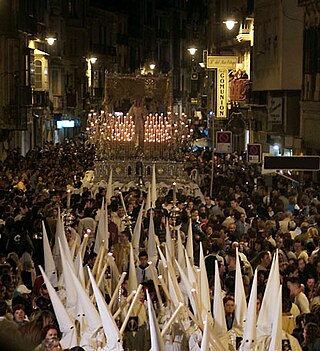
Holy Week in Málaga, is the annual commemoration of the Passion of Jesus in Málaga, Spain. It takes place during the last week of Lent, the week immediately before Easter. It is one of the city's main cultural and religious events.

Holy Week in San Cristóbal de La Laguna is a traditional event that has been repeated for centuries in the historic center of San Cristóbal de La Laguna, a city located on the island of Tenerife, Spain. It is considered the most remarkable Holy Week in the Canary Islands.




















